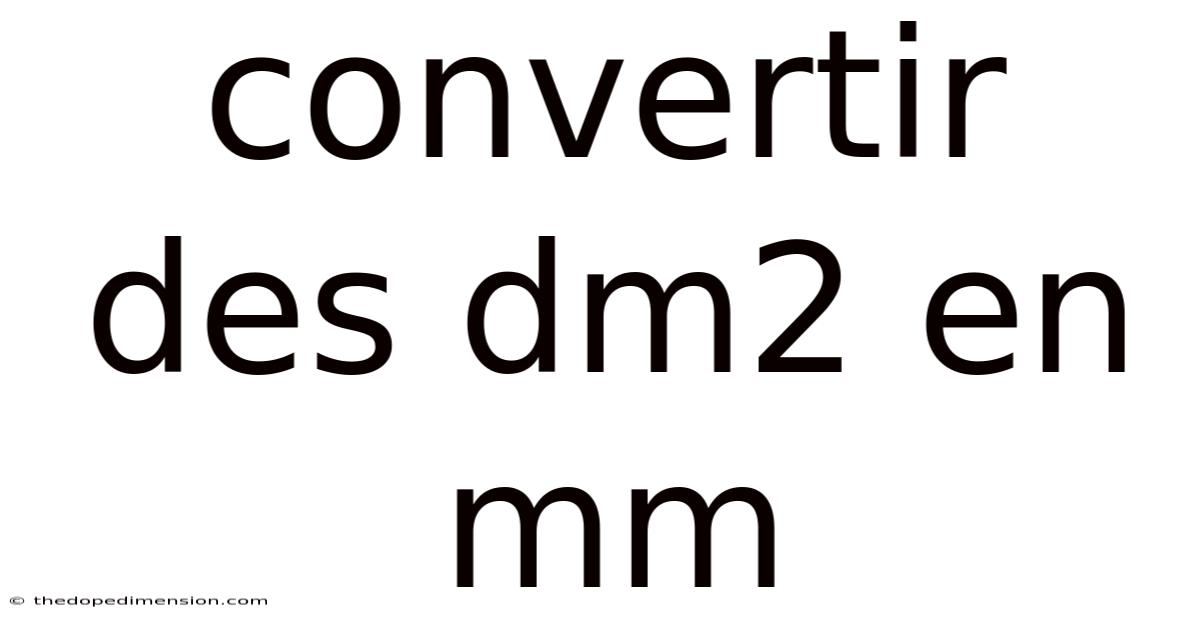Convertir Des Dm2 En Mm
thedopedimension
Sep 12, 2025 · 4 min read

Table of Contents
Converting dm² to mm²: A Comprehensive Guide
Converting square decimeters (dm²) to square millimeters (mm²) might seem like a simple task, but understanding the underlying principles ensures accuracy and builds a strong foundation in metric conversions. This comprehensive guide will walk you through the process, explaining the logic behind the conversion, providing step-by-step instructions, and addressing common questions. Whether you're a student tackling geometry problems, an engineer working on precise measurements, or simply curious about unit conversions, this article will equip you with the knowledge to confidently convert between dm² and mm².
Understanding the Metric System and Square Units
The metric system, or International System of Units (SI), is based on powers of ten. This makes converting between units remarkably straightforward. The prefixes indicate the multiplicative factor. For example:
- deci- (d): Represents 1/10 or 0.1
- centi- (c): Represents 1/100 or 0.01
- milli- (m): Represents 1/1000 or 0.001
When dealing with area, we're not just considering length but length multiplied by length (length²). This means the conversion factors are squared as well. A decimeter (dm) is 1/10 of a meter (m), so a square decimeter (dm²) is (1/10)² or 1/100 of a square meter (m²).
Step-by-Step Conversion: dm² to mm²
The key to converting dm² to mm² lies in understanding the relationship between decimeters and millimeters. One decimeter is equal to 10 centimeters (cm), and one centimeter is equal to 10 millimeters (mm). Therefore, one decimeter equals 100 millimeters (1 dm = 10 cm = 100 mm).
To convert from dm² to mm², we need to square this relationship:
1 dm² = (100 mm)² = 10,000 mm²
This means one square decimeter is equal to 10,000 square millimeters. This is the fundamental conversion factor we'll use for all our calculations.
Here's a step-by-step guide for converting any value from dm² to mm²:
-
Identify the value in dm²: Let's say we have 5 dm².
-
Apply the conversion factor: Multiply the value in dm² by 10,000 mm²/dm².
5 dm² * 10,000 mm²/dm² = 50,000 mm²
-
State the result: Therefore, 5 dm² is equal to 50,000 mm².
Examples of dm² to mm² Conversions
Let's work through a few more examples to solidify your understanding:
-
Example 1: Convert 2.5 dm² to mm²:
2.5 dm² * 10,000 mm²/dm² = 25,000 mm²
-
Example 2: Convert 0.75 dm² to mm²:
0.75 dm² * 10,000 mm²/dm² = 7,500 mm²
-
Example 3: Convert 150 dm² to mm²:
150 dm² * 10,000 mm²/dm² = 1,500,000 mm²
-
Example 4: Convert 0.02 dm² to mm²:
0.02 dm² * 10,000 mm²/dm² = 200 mm²
Working with More Complex Scenarios
The conversion remains consistent even with more complex numbers or scenarios involving fractions and decimals. The key is to always apply the conversion factor of 10,000 mm²/dm².
Practical Applications
Converting between dm² and mm² is crucial in various fields:
-
Engineering and Design: Precision is paramount in engineering. Converting between these units ensures accurate calculations for surface areas, material requirements, and component dimensions.
-
Construction and Architecture: Accurate area calculations are vital for estimating material costs, planning layouts, and ensuring structural integrity.
-
Manufacturing: Precise measurements are essential in manufacturing processes, from designing parts to quality control.
-
Cartography and Mapping: Accurate representation of land areas requires precise conversions between units.
Frequently Asked Questions (FAQ)
Q1: Can I convert from mm² to dm²?
A1: Absolutely! To convert from mm² to dm², simply divide the value in mm² by 10,000. For example, 50,000 mm² / 10,000 mm²/dm² = 5 dm².
Q2: What if I have a value in m² and need to convert it to mm²?
A2: You would first convert m² to dm², then dm² to mm². Remember, 1 m² = 100 dm².
Q3: Why is the conversion factor 10,000?
A3: Because we are dealing with area, we need to square the linear conversion factor. Since 1 dm = 100 mm, then 1 dm² = (100 mm)² = 10,000 mm².
Q4: Are there other units of area I should know about in the metric system?
A4: Yes, the metric system also includes other units of area like square kilometers (km²), square centimeters (cm²), and hectares (ha).
Scientific Explanation
The conversion from dm² to mm² is fundamentally a matter of scaling. We are essentially changing the scale at which we measure the area. The relationship between decimeters and millimeters is linear (1 dm = 100 mm), but the relationship between their squared units is quadratic (1 dm² = 10,000 mm²). This quadratic relationship arises because area is a two-dimensional measurement.
Conclusion
Converting square decimeters to square millimeters is a straightforward process once you understand the fundamental relationship between the units and apply the correct conversion factor. Mastering this conversion is not just about calculating numbers; it's about grasping the principles of the metric system and applying them effectively in various practical contexts. By following the steps outlined in this guide, you'll be able to confidently handle dm² to mm² conversions and enhance your understanding of unit conversions in general. Remember to always double-check your work and practice regularly to reinforce your skills. With consistent practice, you'll become proficient in this essential skill and gain confidence in your ability to tackle more complex measurement problems.
Latest Posts
Latest Posts
-
180 000 Cop To Usd
Sep 12, 2025
-
50 Ml Milk To Cups
Sep 12, 2025
-
2 5 Kg How Many Pounds
Sep 12, 2025
-
W To Btu Hr Conversion
Sep 12, 2025
-
75 Kilometers How Many Miles
Sep 12, 2025
Related Post
Thank you for visiting our website which covers about Convertir Des Dm2 En Mm . We hope the information provided has been useful to you. Feel free to contact us if you have any questions or need further assistance. See you next time and don't miss to bookmark.